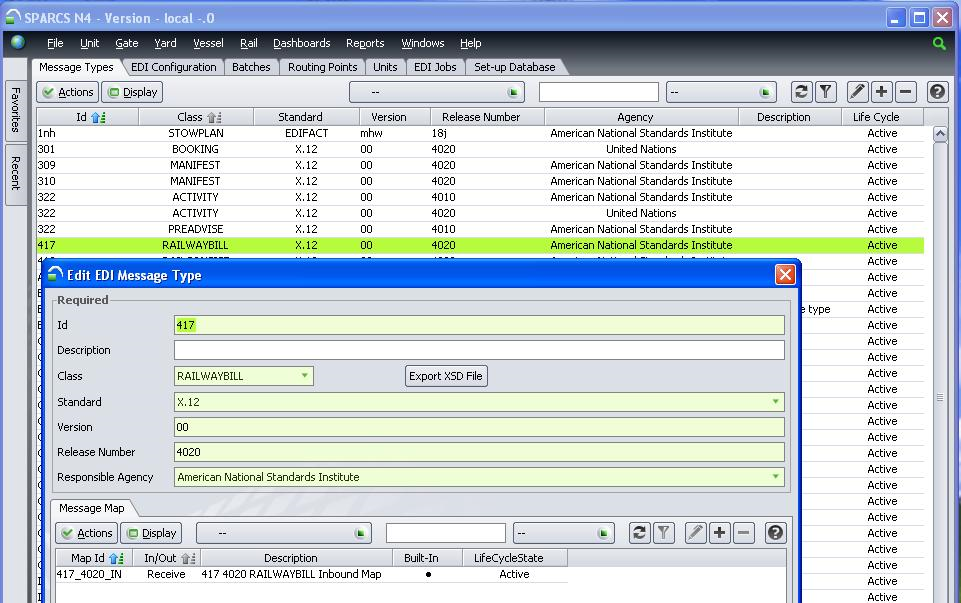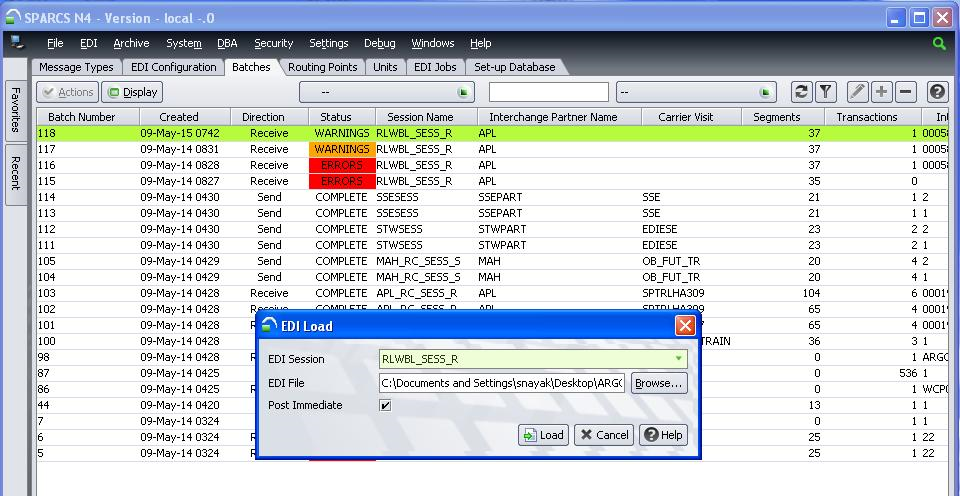
N4 supports ANSI standard 417 Rail Waybill message, release 00 and version 4020.
This Inbound Rail Waybill Message (ANSI 417) permits the transfer of data from a rail carrier to a terminal operator. The Waybill is considered to be at the container level. The inbound or outbound containers are resolved with respect to the current facility port. That is,
If the SPLC code of the current facility port is the same as the SPLC code of the destination port, then it is an inbound container.
If the SPLC code of the current facility port is the same as the SPLC code of the origin port, then it is an outbound container.
The rail operator will send the following details to a terminal operator:
Rail Waybill details (Waybill number and Waybill date)
Vessel visit details, if any
Loaded container details
Attached equipment details
Hazard information, if any, for the individual containers
Booking and/or Bill of Lading numbers
This specification provides the definition of the ANSI 417 Inbound Rail Waybill message to be used in Electronic Data Interchange (EDI). It explains the movement instructions pertinent to a rail carrier shipment. It creates a contract between the shipper and the rail freight carrier and serves as a receipt by the carrier for goods shipped.
This message is sent by the rail carriers to the terminal.
The following sections of this document explains how ANSI 417 Inbound Rail Waybill message is handled in N4 and the scope of its implementation. This use of the message is as follows:
The rail operator sends the inbound rail waybill details to a terminal operator. This waybill is used to resolve the inbound and outbound containers with respect to the current facility. It creates a waybill considering the message function as Original or Create. If the message function provided in the waybill message is Delete, then the existing waybill information gets deleted. However, if the waybill message contains a Booking and/or a BL number, then the unit gets attached to that booking and/or the BL number (if existing).
417 Inbound Supported Segments
The following table illustrates the segments of ANSI standard RAILWAYBILL 00 4020 (417) message and the scope of each segment in N4.
|
S. No. # |
Segment ID |
Supported Qualifier |
Description |
Supported in N4? |
|---|---|---|---|---|
|
1 |
ST |
|
Transaction Set Header |
Supported |
|
2 |
ZC1 |
|
Beginning Segment For Data Correction Or Change |
Supported |
|
3 |
BX |
|
General Shipment Information |
Supported |
|
4 |
BNX |
|
Rail Shipment Information |
Not Supported |
|
5 |
CM |
L, D |
Cargo Manifest |
Supported |
|
6 |
H3 |
|
Special Handling |
Supported |
|
7 |
N9 |
|
Reference Identification |
Supported |
|
8 |
N7 |
|
Equipment Details |
Supported |
|
9 |
M12 |
|
Inbond Identifying information |
Supported |
|
10 |
M7 |
|
Seal Numbers |
Supported |
|
11 |
N8 |
|
Waybill Reference |
Supported |
|
12 |
F9 |
|
Origin Station |
Supported |
|
13 |
D9 |
|
Destination Station |
Supported |
|
14 |
N1 |
|
Name |
Supported |
|
15 |
N2 |
|
Additional Name Information |
Not Supported |
|
16 |
N3 |
|
Address Information |
Not Supported |
|
17 |
N4 |
|
Geographic Location |
Not Supported |
|
18 |
PER |
|
Administrative Communications Contact |
Not Supported |
|
19 |
R2 |
|
Route Information |
Supported |
|
20 |
LH1 |
|
Waybill Hazards Details like count, code,etc. |
Supported |
|
21 |
LH2 |
|
Waybill Hazards Details like temperature,flash point |
Supported |
|
22 |
LH3 |
|
Shipping Name |
Supported |
|
23 |
LFH |
|
Material Description |
Supported |
|
24 |
PER |
|
Material Contact |
Not Supported |
|
25 |
LX |
|
Assigned Number |
Not Supported |
|
26 |
L5 |
|
Description, Marks and Numbers |
Supported |
|
27 |
L0 |
|
Line Item - Quantity and Weight |
Not Supported |
|
28 |
SE |
|
Transaction Set Trailer |
Supported |
417 Inbound Rail Waybill - Message Functions
As per ANSI standard, the Rail Waybill Inbound message has various message function codes in the BX (the 1st element) segment. But in the Inbound message, N4 supports only the following message functions: Original (00), Add (02) and Delete (03).
For information on the EDI message functions supported by Rail Waybill, see Supported EDI message functions (on page 1).
N4 serves a built-in map for converting the ANSI 417 Inbound EDI message standard in to a Navis standard rail waybill xml file using the Navis standard schema file: railwaybill.xsd.
Following are the related files that can be downloaded as part of N4 application:
ansi417_00_4020.mgt - GoXml map
417.dic - ANSI standard dictionary
railwaybill.xsd - Navis standard xml schema
If there is any secondary rail operator (additional R2 segment), then the equipment is treated as a transship container.
Facility is optional in the railwaybill message. But because a facility is required to process a rail waybill message, a custom map can be created from N4 built-in map and the facility field can be mapped to a constant value.
Alternatively, refer section 1.3 (Configuring facility in an EDI session) below.
N4 creates vessel visits automatically. A unit's IB or OB category should be updated only if the unit is attached to a TBA_TRAIN.
Following conditions apply only for outbound units:
If a unit already has a booking existing in the system, then it should update the vessel visit associated with that booking for the received unit.
A parameter ARGORAILWAYBILL001- Allow auto creation of foreign vessel visit will be supported, which can be configured to make the Rail Waybill message create vessel visits automatically for only a Non-Operational facility.
417 Inbound - Configuring facility in an EDI Session
N4 requires facility information to process a rail way bill message. It can be sent to N4 in two ways - The first method is specified in section 1.2.4 and the other one is explained below. When creating an EDI session for a Rail Waybill message, a setting can be added to specify the facility value. N4 will use this facility to process the Waybill message and will advise units at this facility. The setting name is : ARGORAILWAYBILL003 - Facility to post rail waybill messages.
If facility is not specified in any of the above two ways, N4 will throw an error.
How to Configure N4 for Inbound 417 Rail Waybill?
The following steps explain how to set up and process an inbound Rail Waybill message in N4.
To set up an inbound Rail Waybill message:
Create the Message Type and Message Map for the Inbound RailWaybill.

Create the Mailbox and Session for the Inbound Rail Waybill.

Load and post the Inbound Rail Waybill EDI file.
To load an inbound Rail Waybill message:
Go to Administration > EDI > Load. A new form will be displayed.
Select the desired rail waybill session in the EDI Session drop-down.
Browse the desired EDI file to post in the application.
Select the Post Immediate check box for posting the file immediately after loading the file.
Click on the Load button to load the file. The progress bar will show the following message "Edi Job Completed".
Click OK.

Verify the batch for the status of the file posted.
In an ideal scenario, all the processes should show the status as COMPLETE/WARNING. If there are any errors, then rectify and repost the file.
ANSI 417 Inbound Rail Waybill EDI with message function as original (00)/create(02)
ISA*04* *00* *ZZ*APL *ZZ*APL *080609*0345*U*00401*000586492*0*P*>
GS*WB*APL*APL*20080609*0345*586492*X*004010
ST*417*864920001
ZC1*NA*TRLU*652862*992811**CO*CSXT*X
BX*02*X*PP**CSXT*L*W*N
BNX*M**S
N9*BM*USPNY6608***0923*ET
N9*BN*USPNY6608***0923
N9*P8*35110988
CM*216R*L*USOAK******FSECL01
N7*TRLU*652862*2000*N***APL*CN**4000***2200*U000
M12*INBOND STATUS02***INBOND STATUS06
M7*SEAL1*SEAL2*SEAL3*SEAL4
N8*992811*
F9*72168*CLEVELAND*OH*****664422
D9*89630*ELIZABETH MARINE TE*NJ*****191821
N1*SH*ZIM AMERICAN INTEGRATED SHIPNG
N4*CLEVELAND*OH
N1*CN*ZIM AMERICAN INTEGRATED SHIPNG
N4*ELIZABETH MARINE TE*NJ
N1*PF*ZIM AMERICAN INTEGRATED SHIPNG
N3*ATTN ACCOUNTS PAYABLE*5801 LAKE WRIGHT DRIVE
N4*NORFOLK*VA*23502
N1*N1*BILL TOPPS
PER*NT**TE*7183131964
R2*CSXT*S***85
H3*SPL INS**85
LX*1
L5*1*CONTAINERS, DEMOUNTABLE*4221130*T
L0*1***2000*N
PI*CT*5004***CSXT*AGRT
LH1***CODE4
LH2*CLS1
LH3*HAZARDOUS DESC
SE*26*864920001
GE*1*586492
IEA*1*000586492
ANSI 417 Inbound Rail Waybill EDI with message function as delete(03)
When the message function, that is, the first element of the BX segment is 03 *(BX*03)*, then the message deletes the rail waybill message. In this case, the unit must be available in the system and the received waybill number must match with the existing waybill number attached to that unit. If this condition is satisfied, then the deletion of waybill will be performed in either of the two cases (mentioned below) when the unit is in advised state:
The unit is deleted from the application if the inbound and outbound visit information are generic (i.e. both the IB and OB are TBA_TRAIN/GEN_VESSEL).
The unit waybill information (that is, waybill number and waybill date) is removed if the routing information is not generic.